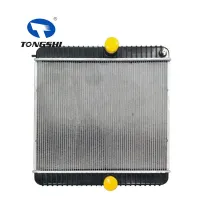What does a car radiator do?
The car radiator consists of a water inlet chamber, a water outlet chamber and a radiator core. Antifreeze flows into the radiator core and air flows out of the radiator. Hot antifreeze cools by radiating heat to the air, while cold air heats by absorbing the heat emitted by the antifreeze.
The car radiator functions as both water storage and heat dissipation. The radiator is a major part of the cooling system and its purpose is to protect the engine from damage caused by overheating. The principle of the radiator is to use cold air to reduce the temperature of the coolant coming from the engine in the radiator. The radiator belongs to the automobile cooling system. The radiator in the engine water cooling system consists of three parts: a water inlet chamber, a water outlet chamber, a main plate and a radiator core. The radiator cools the coolant that has reached high temperatures. The coolant in the radiator becomes cold when the tubes and fins of the radiator are exposed to the airflow generated by the cooling fan and the movement of the vehicle.
To prevent the engine from overheating, the components surrounding the combustion chamber (cylinder liners, cylinder heads, valves, etc.) must be properly cooled. In order to ensure the cooling effect, the automobile cooling system generally consists of a radiator, thermostat, water pump, cylinder water channel, cylinder head water channel, fan, etc. The radiator is responsible for cooling circulating water. Its water pipes and heat sinks are mostly made of aluminum. The aluminum water pipes are made into a flat shape and the heat sinks are corrugated. Pay attention to the heat dissipation performance. The installation direction is perpendicular to the direction of air flow. Try to achieve The wind resistance should be small and the cooling efficiency should be high. Coolant flows inside the radiator core and air passes outside the radiator core. The hot coolant becomes cold by dissipating heat to the air, and the cold air heats up by absorbing the heat emitted by the coolant, so the radiator is a heat exchanger.

The tank's radiator should not come into contact with any acid, alkali or other corrosive substances. It is recommended to use soft water. Hard water should be softened before use to prevent clogging and scaling inside the water tank radiator. Use coolant to prevent corrosion of the radiator. Please use long-lasting anti-rust coolant produced by regular manufacturers that meets national standards. During the installation of the water tank radiator, please do not damage the radiator strip (piece) or hit the water tank radiator to ensure heat dissipation capacity and sealing. When the radiator is completely drained and then filled with water, you need to open the water drain switch of the engine cylinder first, wait for the water to flow out, and then close it to prevent foaming. During normal use, the water level should be checked at any time, and water should be added after stopping the machine to cool down. When adding water, slowly open the water tank cover and keep the staff as far away from the water inlet as possible to prevent burns from the high-pressure steam ejected from the water inlet.
In winter, in order to avoid core cracking caused by freezing, such as long-term parking or indirect parking, the water tank cover and drain switch should be used to drain all the water. The effective environment of the spare water tank radiator should be ventilated and dry. Depending on the actual situation, users should thoroughly clean the water tank radiator core within 1 to 3 months. When cleaning, rinse with clean water along the side opposite to the wind direction. The water level gauge should be cleaned every three months or, depending on the actual situation, all parts should be dismantled and cleaned with warm water and non-corrosive detergent.
The heat dissipation effect of car radiators is very ideal and is indispensable in cars. In normal times, we not only need to master how to use the water tank radiator well, but also learn to maintain the water tank radiator regularly, so as to ensure the normal operation of the water tank radiator and make the water tank radiator last longer.


